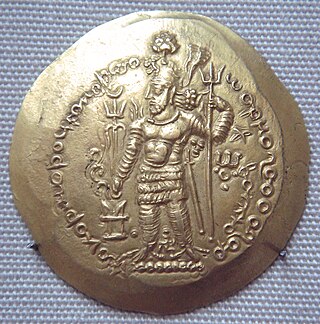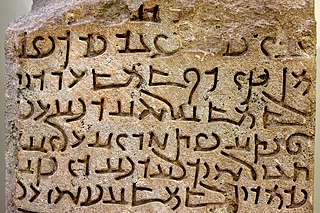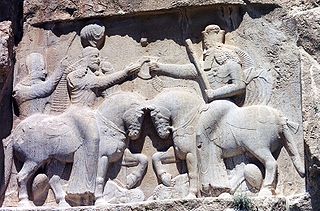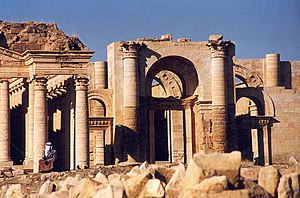The 270s decade ran from January 1, 270, to December 31, 279.
The 240s decade ran from January 1, 240, to December 31, 249.
The 260s decade ran from January 1, 260, to December 31, 269.
Year 241 (CCXLI) was a common year starting on Friday of the Julian calendar. At the time, it was known as the Year of the Consulship of Gordianus and Pompeianus by the Romans. The denomination 241 for this year has been used since the early medieval period, when the Anno Domini calendar era became the prevalent method in Europe for naming years.

Septimia Zenobia was a third-century queen of the Palmyrene Empire in Syria. Many legends surround her ancestry; she was probably not a commoner and she married the ruler of the city, Odaenathus. Her husband became king in 260, elevating Palmyra to supreme power in the Near East by defeating the Sasanian Empire of Persia and stabilizing the Roman East. After Odaenathus' assassination, Zenobia became the regent of her son Vaballathus and held de facto power throughout his reign.

Year 272 (CCLXXII) was a leap year starting on Monday of the Julian calendar. At the time, it was known as the Year of the Consulship of Postumius and Veldumnianus. The denomination 272 for this year has been used since the early medieval period, when the Anno Domini calendar era became the prevalent method in Europe for naming years.

Hormizd-Ardashir, better known by his dynastic name of Hormizd I, was the third Sasanian King of Kings (shahanshah) of Iran, who ruled from May 270 to June 271. He was the third-born son of Shapur I, under whom he was governor-king of Armenia, and also took part in his father's wars against the Roman Empire. Hormizd I's brief time as ruler of Iran was largely uneventful. He built the city of Hormizd-Ardashir, which remains a major city today in Iran. He promoted the Zoroastrian priest Kartir to the rank of chief priest (mowbed) and gave the Manichaean prophet Mani permission to continue his preaching.

Shapur I was the second Sasanian King of Kings of Iran. The precise dating of his reign is disputed, but it is generally agreed that he ruled from 240 to 270, with his father Ardashir I as co-regent until the death of the latter in 242. During his co-regency, he helped his father with the conquest and destruction of the city of Hatra, whose fall was facilitated, according to Islamic tradition, by the actions of his future wife al-Nadirah. Shapur also consolidated and expanded the empire of Ardashir I, waged war against the Roman Empire, and seized its cities of Nisibis and Carrhae while he was advancing as far as Roman Syria. Although he was defeated at the Battle of Resaena in 243 by Roman emperor Gordian III, he was the following year able to win the Battle of Misiche and force the new Roman emperor Philip the Arab to sign a favorable peace treaty that was regarded by the Romans as "a most shameful treaty".

Ardashir I, also known as Ardashir the Unifier, was the founder of the Persian Sasanian Empire. He was also Ardashir V of the Kings of Persis, until he founded the new empire. After defeating the last Parthian shahanshah Artabanus IV on the Hormozdgan plain in 224, he overthrew the Arsacid dynasty and established the Sasanian dynasty. Afterwards, Ardashir called himself "shahanshah" and began conquering the land that he called Iran.

Vologases V was King of Kings of the Parthian Empire from 191 to 208. As king of Armenia, he is known as Vologases II. Not much is known about his period of kingship of Armenia, except that he put his son Rev I on the Iberian throne in 189. Vologases succeeded his father Vologases IV as king of the Parthian Empire in 191; it is uncertain if the transition of power was peaceful or if Vologases took the throne in a civil war. When Vologases acceded the Parthian throne, he passed the Armenian throne to his son Khosrov I.

Septimius Vaballathus was emperor of the Palmyrene Empire centred at Palmyra in the region of Syria. He came to power as a child under his regent mother Zenobia, who led a revolt against the Roman Empire and formed the independent Palmyrene Empire.

The Battle of Emesa was fought in 272 between the Roman armies led by their emperor Aurelian and the Palmyrene forces led by their empress, Zenobia and general Zabdas.

The Sasanian Empire, officially Ērānšahr, was the last empire of ancient Iran. Named after the House of Sasan, it endured for over four centuries, from 224 to 651, making it the second longest-lived imperial Iranian dynasty after the directly preceding Arsacid dynasty of Parthia.

The Kingdom of Hatra,also called Kingdom of Arabaya and Araba. was a 2nd-century Arab kingdom located between the Roman Empire and the Parthian Empire, mostly under Parthian suzerainty, in modern-day northern Iraq.

Hatran Aramaic designates a Middle Aramaic dialect, that was used in the region of Hatra and Assur in northeastern parts of Mesopotamia, approximately from the 3rd century BC to the 3rd century CE. Its range extended from the Nineveh Plains in the centre, up to Tur Abdin in the north, Dura-Europos in the west and Tikrit in the south.

The Sassanid Empire or Sassanian Dynasty is the name used for the Persian dynasty which lasted from 224 to 651 AD.
The siege of Nisibis took place when the Sasanians under Shah Shapur I besieged the Roman city of Nisibis in 252. This marks the beginning of Shapur's I second invasion of the Roman empire which saw the first Sassanid invasion of Syria; the year of the invasion is debated as Shapur's inscription from Naqsh-e Rustam regarding his second campaign against Rome do not mention the city of Nisibis. But Syriac and Arabic sources, mainly the Chronicle of Seert and Al-Tabari, mention that Shapur took Nisibis in his eleventh regnal year; according to the historian David Stone Potter, this regnal year is 252. Another Syriac account, the Liber Caliphorum, from the eighth century, mentions the invasion of the city in 252.

The fall of Hatra, capital of the Kingdom of Hatra under Sanatruq II, took place in the 3rd century after a lengthy siege by the Sasanian king Shapur I. Hatra was plundered and abandoned, and its kingdom dissolved.

Coele Syria was a Roman province which Septimius Severus created with Syria Phoenice in 198 by dividing the province of Syria. Its metropolis was Antioch.

The Mesopotamian campaigns of Ardashir I represented the first episode in a new period of wars between the Romans and Sasanids. The war between the Roman Empire, ruled by the Roman emperor Severus Alexander (222-235), and the Sasanian rule, led by Ardashir I (224-241), lasted for more than a decade, from 229 to 241 when the Sasanian ruler died and was replaced by his son, Shapur I.















